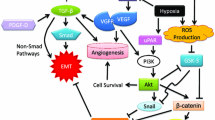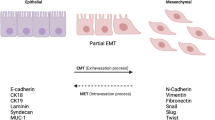Abstract
Breast cancer remains a serious public health issue despite early diagnosis and aggressive treatment. This chapter discusses the molecular mechanism by which epithelial mesenchymal transition (EMT) occurs and its implication for metastasis. The chapter also discusses how the different subsets, including cancer stem cells, contribute to cancer evasion and resistance, through dormancy. Included in the discussion are studies on mesenchymal stem cells as protection for the cancer cells from immune clearance. We reviewed the growing information on microRNA (miRNA) in the cellular mechanisms of EMT and its role in facilitating metastasis and/or dormancy of the cancer cells. Overall, this chapter provides a “snapshot” of EMT and miRNA in breast cancer dormancy and metastasis.
Grant support: This work was funded by the Department of Defense.
Access this chapter
Tax calculation will be finalised at checkout
Purchases are for personal use only
Similar content being viewed by others
References
Al-Hajj M, Wicha MS, Benito-Hernandez A, et al. Prospective identification of tumorigenic breast cancer cells. Proc Natl Acad Sci. 2003;100:3983–8.
Arvey A, Larsson E, Sander C, et al. Target mRNA abundance dilutes microRNA and siRNA activity. Mol Syst Biol 2010; 6:363, doi: 10.1038/msb.2010.24.
Bader AG. miR-34: A microRNA replacement therapy is headed to the clinic. Frontiers in Genetics 2012; 3:120. doi: 10.3389/fgene.2012.00120.
Bartel DP. MicroRNAs: Target recognition and regulatory functions. Cell. 2009;136:215–33.
Batlle R, Alba-Castellon L, Loubat-Casanovas J, et al. Snail1 controls TGF-[beta] responsiveness and differentiation of mesenchymal stem cells. Oncogene (In press).
Bendre MS, Margulies AG, Walser B, et al. Tumor-derived interleukin-8 stimulates osteolysis independent of the receptor activator of nuclear factor- + ¦B ligand pathway. Cancer Res. 2005;65:11001–9.
Binaco P. Minireview: The Stem Cell Next Door: Skeletal and Hematopoietic Stem Cell ‘Niches’ in Bone. Endocrinol. 2011;152:2957–62.
Braun S, Vogl FD, Naume B, et al. A pooled analysis of bone marrow micrometastasis in breast cancer. N Engl J Med. 2005;353:793–802.
Braun S, Auer D, Marth C. The prognostic impact of bone marrow micrometastases in women with breast cancer. Cancer Invest. 2009;27:598–603.
Castano Z, Tracy K, McAllister SS. The tumor macroenvironment and systemic regulation of breast cancer progression. Int J Dev Biol. 2011;55:889–97.
Chaffer CL, Thompson EW, Williams ED. Mesenchymal to epithelial transition in development and disease. Cells Tissues Organs. 2007;185(1–3):7–19.
Cho JA, Park H, Lim EH, et al. Exosomes from breast cancer cells can convert adipose tissue-derived mesenchymal stem cells into myofibroblast-like cells. Int J Oncol. 2012;40:130–8.
Corcoran KE, Trzaska KA, Fernandes H, et al. Mesenchymal stem cells in early entry of breast cancer into bone marrow. PLoS ONE. 2008;3:e2563.
Decker T, Fischer G, Bucke W, et al. Increased number of regulatory T cells (T-regs) in the peripheral blood of patients with Her-2/neu-positive early breast cancer. J Cancer Res Clin Oncol (In press).
Deng G, Chen LC, Schott DR, et al. Loss of heterozygosity and p53 gene mutations in breast cancer. Cancer Res. 1994;54:499–505.
Feng B, Wang R, Chen LB. Review of MiR-200b and cancer chemosensitivity. Biomed Pharmacother (In press).
Fidler IJ. The pathogenesis of cancer metastasis: the ‘seed and soil’ hypothesis revisited. Nat Rev Cancer. 2003;3:453–8.
Flugel D, Gorlach A, Michiels C, et al. Glycogen synthase kinase 3 phosphorylates hypoxia-inducible factor 1alpha and mediates its destabilization in a VHL-independent manner. Mol Cell Biol. 2007;27:3253–65.
Goldstein RH, Reagan MR, Anderson K, et al. Human bone marrow-derived MSCs can home to orthotopic breast cancer tumors and promote bone metastasis. Cancer Res. 2010;70:10044–50.
Gompel A. Breast cancer incidence rates in US women are no longer declining. Climacteric. 2011;14:690–1.
Grisendi G, Bussolari R, Veronesi E, et al. Understanding tumor-stroma interplays for targeted therapies by armed mesenchymal stromal progenitors: the Mesenkillers. Am J Cancer Res. 2011;1:787–805.
Guise TA, Yin JJ, Taylor SD, et al. Evidence for a causal role of parathyroid hormone-related protein in the pathogenesis of human breast cancer-mediated osteolysis. J Clin Invest. 1996;98:1544–9.
Guzy RD, Schumacker PT. Oxygen sensing by mitochondria at complex III: the paradox of increased reactive oxygen species during hypoxia. Exp Physiol. 2006;91:807–19.
Han M, Liu M, Wang Y, et al. Antagonism of miR-21 reverses epithelial-mesenchymal transition and cancer stem cell phenotype through AKT/ERK1/2 inactivation by targeting PTEN. PLoS ONE. 2012;7:e39520.
Hanahan D, Weinberg R. Hallmarks of cancer: the next generation. Cell. 2011;144:646–74.
Hart IR, Fidler IJ. Role of organ selectivity in the determination of metastatic patterns of B16 melanoma. Cancer Res. 1980;40:2281–7.
Hauschka PV, Mavrakos AE, Iafrati MD, et al. Growth factors in bone matrix. Isolation of multiple types by affinity chromatography on heparin-Sepharose. J Biol Chem. 1986;261:12665–74.
Hockel M, Vaupel P. Biological consequences of tumor hypoxia. Semin Oncol. 2001;28:36–41.
Holmgren L, O’Reilly MS, Folkman J. Dormancy of micrometastases: balanced proliferation and apoptosis in the presence of angiogenesis suppression. Nat Med. 1995;1:149–53.
Horlock C, Stott B, Dyson PJ, et al. The effects of trastuzumab on the CD4 + CD25 + FoxP3 + and CD4 + IL17A + T-cell axis in patients with breast cancer. Br J Cancer. 2009;100:1061–7.
Hynes RO. Integrins: bidirectional, allosteric signaling machines. Cell. 2002;110:673–87.
Jorgensen K. Is the tide turning against breast screening? Breast Cancer Res. 2012;14(4):107.
Karnoub AE, Dash AB, Vo AP, et al. Mesenchymal stem cells within tumour stroma promote breast cancer metastasis. Nature. 2007;449:557–63.
Kim R, Emi M, Tanabe K. Cancer cell immune escape and tumor progression by exploitation of anti-inflammatory and pro-inflammatory responses. Cancer Biol Ther. 2005;4(9):924–33.
Ko LJ, Prives C. p53: puzzle and paradigm. Genes Dev. 1996;10:1054–72.
Le Blanc K, Mougiakakos D. Multipotent mesenchymal stromal cells and the innate immune system. Nat Rev Immunol. 2012;12:383–96.
Lim PK, Bliss SA, Patel SA, et al. Gap junction-mediated import of MicroRNA from bone marrow stromal cells can elicit cell cycle quiescence in breast cancer cells. Cancer Res. 2011;71:1550–60.
Lowe SW, Ruley HE. Stabilization of the p53 tumor suppressor is induced by adenovirus 5 E1A and accompanies apoptosis. Genes Dev. 1993;7:535–45.
Lv K, Liu L, Wang L, et al. Lin28 mediates paclitaxel resistance by modulating p21, Rb and Let-7a miRNA in breast cancer cells. PLoS ONE. 2012;7:e40008.
Manel N, Unutmaz D, Littman DR. The differentiation of human TH-17 cells requires transforming growth factor-[beta] and induction of the nuclear receptor ROR[gamma]t. Nat Immunol. 2008;9:641–9.
Mathiesen RR, Borgen E, Renolen A, et al. Persistence of disseminated tumor cells after neoadjuvant treatment for locally advanced breast cancer predicts poor survival. Breast Cancer Res. 2012;14:R117.
Mishra PJ, Mishra PJ, Glod JW, et al. Mesenchymal stem cells: flip side of the coin. Cancer Res. 2009;69:1255–8.
Moharita AL, Taborga M, Corcoran KE, et al. SDF-1alpha regulation in breast cancer cells contacting bone marrow stroma is critical for normal hematopoiesis. Blood. 2006;108:3245–52.
Mukherji S, Ebert MS, Zheng GXY, et al. MicroRNAs can generate thresholds in target gene expression. Nat Genet. 2011;43:854–9.
Norton L, Massague J. Is cancer a disease of self-seeding? Nat Med. 2006;12:875–8.
Ochsenbein AF, Klenerman P, Karrer U, et al. Immune surveillance against a solid tumor fails because of immunological ignorance. Proc Natl Acad Sci. 1999;96:2233–8.
Paget S. The distribution of secondary growths in cancer of the breast. 1889. Cancer Metastasis Rev. 1989;8:98–101.
Parr C, Watkins G, Jiang WG. The possible correlation of Notch-1 and Notch-2 with clinical outcome and tumour clinicopathological parameters in human breast cancer. Int J Mol Med. 2004;14:779–86.
Patel SA, Meyer JR, Greco SJ, et al. Mesenchymal stem cells protect breast cancer cells through regulatory T cells: role of mesenchymal stem cell-derived TGF-beta. J Immunol. 2010;184:5885–94.
Patel SA, Dave MA, Murthy RG, et al. Metastatic breast cancer cells in the bone marrow microenvironment: novel insights into oncoprotection. Oncol Rev. 2011;5:93–102.
Pelger RCM, Hamdy NAT, Zwinderman AH, et al. Effects of the bisphosphonate olpadronate in patients with carcinoma of the prostate metastatic to the skeleton. Bone. 1998;22:403–8.
Plumas J, Chaperot L, Richard MJ, et al. Mesenchymal stem cells induce apoptosis of activated T cells. Leukemia. 2005;19:1597–604.
Rao G, Patel PS, Idler SP, et al. Facilitating role of preprotachykinin-I gene in the integration of breast cancer cells within the stromal compartment of the bone marrow. Cancer Res. 2004;64:2874–81.
Reya T, Clevers H. Wnt signalling in stem cells and cancer. Nature. 2005;434:843–50.
Reya T, Morrison SJ, Clarke MF, Weissman IL. Stem cells, cancer, and cancer stem cells. Nature. 2001;414:105–11.
Rhodes DJ, O’Connor MK, Phillips SW, et al. Molecular breast imaging: a new technique using technetium Tc 99m scintimammography to detect small tumors of the breast. Mayo Clinic Proc. 2005;80:24–30.
Ryo A, Nakamura M, Wulf G, et al. Pin1 regulates turnover and subcellular localization of [beta]-catenin by inhibiting its interaction with APC. Nat Cell Biol. 2001;3:793–801.
Sarkar FH, Li Y, Wang Z, et al. Implication of microRNAs in drug resistance for designing novel cancer therapy. Drug Resist Updates. 2010;13:57–66.
Shackleton M, Vaillant F, Simpson KJ, Stingl J, Smyth GK, Asselin-Labat ML, Wu L, Lindeman GJ, Visvader JE. Generation of a functional mammary gland from a single stem cell. Nature. 2006;439:84–8.
Shi Y, Massague J. Mechanisms of TGF-beta signaling from cell membrane to the nucleus. Cell. 2003;113:685–700.
Solakoglu O, Maierhofer C, Lahr G, et al. Heterogeneous proliferative potential of occult metastatic cells in bone marrow of patients with solid epithelial tumors. Proc Natl Acad Sci. 2002;99:2246–51.
Subramaniam K, Hirpara JL, Tucker-Kellogg L, et al. FLIP: A flop for execution signals. Cancer Lett (In press).
Talmadge JE. Clonal selection of metastasis within the life history of a tumor. Cancer Res. 2007;67:11471–5.
Tarin D, Price JE, Kettlewell MG, et al. Clinicopathological observations on metastasis in man studied in patients treated with peritoneovenous shunts. Br Med J. 1984a;288:749–51.
Tarin D, Price JE, Kettlewell M, G W, et al. Mechanisms of human tumor metastasis studied in patients with peritoneovenous shunts. Cancer Res. 1984b;44:3584–92.
Ten HA, Bektas N, von SS, et al. Expression of the glioma-associated oncogene homolog (GLI) 1 in human breast cancer is associated with unfavourable overall survival. BMC Cancer. 2009;9:298.
Thiery JP, Sleeman JP. Complex networks orchestrate epithelial-mesenchymal transitions. Nat Rev Mol Cell Biol. 2006;7:131–42.
Thiery JP, Acloque H, Huang RYJ, et al. Epithelial-Mesenchymal transitions in development and disease. Cell. 2009;139:871–90.
Uhr JW, Pantel K. Controversies in clinical cancer dormancy. Proc Natl Acad Sci. 2011;108:12396–400.
van DA, Naaijkens BA, Jurgens WJ, et al. The multidrug resistance protein breast cancer resistance protein (BCRP) protects adipose-derived stem cells against ischemic damage. Cell Biol Toxicol (In press).
Vogelstein B, Lane D, Levine AJ. Surfing the p53 network. Nature. 2000;408:307–10.
Wang Z, Li Y, Ahmad A, Azmi AS, Kong D, Banerjee S, Sarkar FH. Targeting miRNAs involved in cancer stem cell and EMT regulation: an emerging concept in overcoming drug resistance. Drug Resist Updates. 2010;13:109–18.
Wang H, Tan G, Dong L, Cheng L, Li K, Wang Z, Luo H. Circulating MiR-125b as a marker predicting chemoresistance in breast cancer. PLoS ONE. 2012;7:e34210.
Zardawi SJ, O’Toole SA, Sutherland RL, Musgrove EA. Dysregulation of Hedgehog, Wnt and Notch signalling pathways in breast cancer. Histol Histopathol. 2009;24:385–98.
Zen K, Zhang CY. Circulating MicroRNAs: a novel class of biomarkers to diagnose and monitor human cancers. Med Res Rev. 2012;32:326–48.
Author information
Authors and Affiliations
Corresponding author
Editor information
Editors and Affiliations
Rights and permissions
Copyright information
© 2014 Springer Science+Business Media New York
About this chapter
Cite this chapter
Nahas, G., Bibber, B., Rameshwar, P. (2014). MicroRNAs in Epithelial Mesenchymal Transition and Breast Cancer Progression. In: Singh, S., Rameshwar, P. (eds) MicroRNA in Development and in the Progression of Cancer. Springer, New York, NY. https://doi.org/10.1007/978-1-4899-8065-6_6
Download citation
DOI: https://doi.org/10.1007/978-1-4899-8065-6_6
Published:
Publisher Name: Springer, New York, NY
Print ISBN: 978-1-4899-8064-9
Online ISBN: 978-1-4899-8065-6
eBook Packages: Biomedical and Life SciencesBiomedical and Life Sciences (R0)




